QlikView QSDA2018 Qlik Sense Data Architect Certification Exam Online Training
QlikView QSDA2018 Online Training
The questions for QSDA2018 were last updated at Feb 07,2025.
- Exam Code: QSDA2018
- Exam Name: Qlik Sense Data Architect Certification Exam
- Certification Provider: QlikView
- Latest update: Feb 07,2025
A car manufacturer has several QlikView apps. The manufacturer decides to migrate some specific apps to Qlik Sense. The manufacturer decides to migrate some specific wants to reuse front-end variables from the previous QlikView app.
Which strategy should a data architect use to meet these requirements?
- A . Use the QlikView converter within the Dev Hub of Qlik Sense
- B . Drag and drop a QVM file into the Qlik Sense hub and create a new app
- C . Export the existing LOAD script into a QVS file for later reuse in Qlik Sense
- D . Copy and paste the LOAD script of the existing QlikView app into the new app.
A healthcare organization needs an app to track patient encounters, patient lab orders, and patient medications.
– Encounters, lab orders, and medication data are maintained in three separate tables linked by PatientID
– PatientID values in all three tables are completely accurate
– Patients may have encounters without lab orders or medications
The data architect needs to make sure that the count of patient lab orders is correct.
Which method should the data architect to meet this requirement?
- A . Load all three tables, create a copy of PatientID in the lab orders table as LabPatientID, and use Count (Distinct LabPatientID)
- B . load all three tables and use Count(Distinct PatientID)
- C . load all three tables and use Count(PatientID)
- D . Load all three tables, create a copy of PatientID in the lab orders table as LabPatientID, and use count (LabPatientID)
Refer to the exhibit.
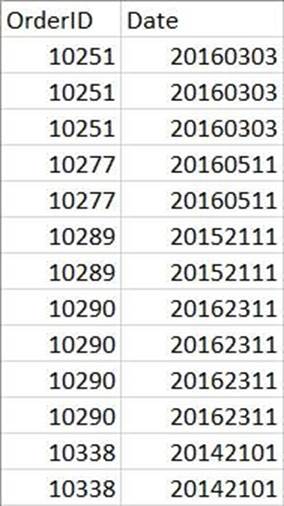
A data architect needs to build a sales dashboard. Data is stored in a legacy database. The extracted data contains the date in the format, ‘YYYDDMM’. Due to the source date format, the dates are being loaded as numbers.
Which function should the data architect use to fix this issue?
- A . Timestamp
- B . Date
- C . Date#
- D . Timestamp#
A data architect uses the Qlik GeoAnalytics connector to determine the closest airports to cities in an existing app. The built location generates data for the airport locations. The data load editor runs the script and sees a circular reference and a synthetic key.
How should the data architect fix these issues?
- A . When selecting an operation in the Qlik GeoAnalytics connector, select Only load distinct.
- B . When choosing which data to load, uncheck the non-unique field in the new data tables.
- C . Concatenate the airport table and the existing tables into one master tables.
- D . When selecting an operation in the Qlik GeoAnalytics connector, change the CRS to “None”.
Refer to the exhibits.
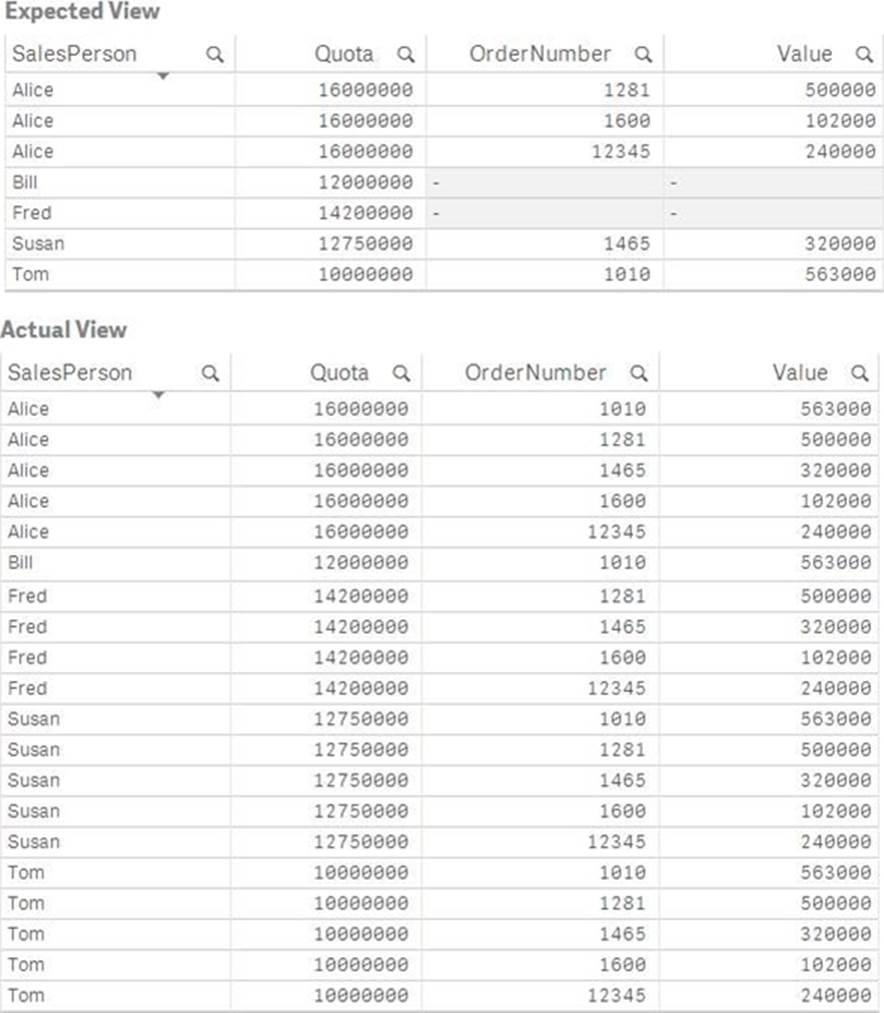
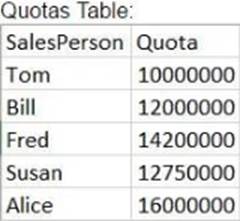
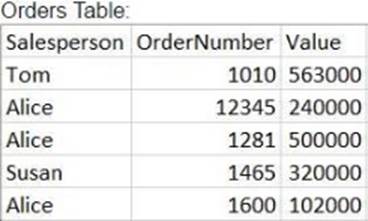
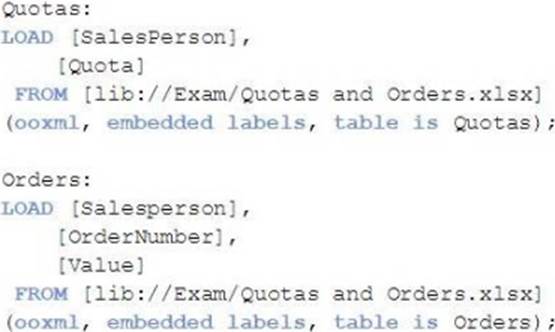
Which corrective action should be taken to achieve the expected view?
- A . Alias one of the fields in the Orders table.
- B . Use distinctin the LOAD statement.
- C . Use Upper () to align the SalesPerson fields.
- D . Add a link table.
Refer to the exhibit.
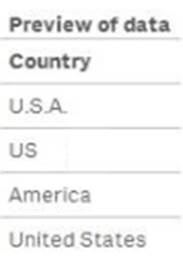
The business analyst previews some data and notices different values for the United States in the Country field. The analyst must be able to report the total sales for the United States. The data architect must fix this issue in the LOAD script.
Which function should the data architect use to fix data quality issue?
- A . Switch
- B . ApplyMap
- C . Case
- D . Replace
Refer to the exhibit.
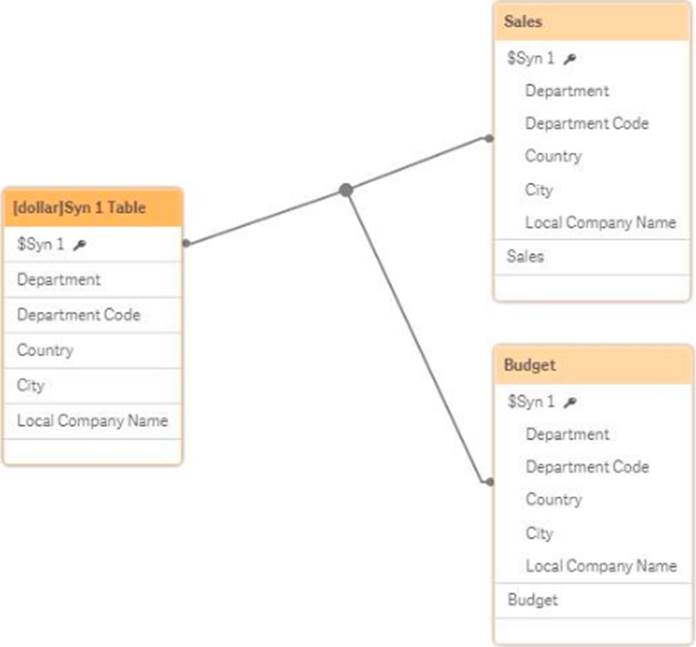
The data model shown has a synthetic key for information that contains actual sales and budget sales for a multi-national company. As a business requirement, users must be able to drill down by department and country. Data must not be lost. Due to data quality issues, some departments are NOT included in the Sales and Budget tables. The data architect needs a method to eliminate synthetic keys that generates the fastest performing data model.
Which method should the data architect use?
- A . A link table to associate the two tables.
- B . A forced concatenation statement.
- C . Field aliases or comment out redundant fields.
- D . A Left Join statement in the script.
Refer to the exhibit.
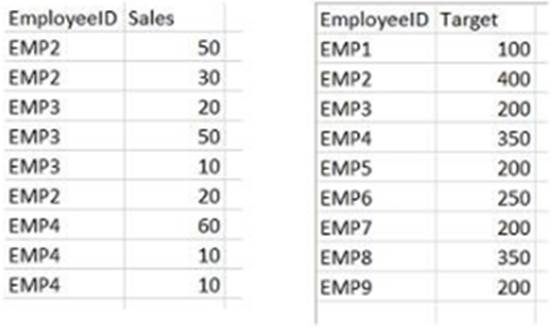

A data architect has two tables that contain Sales and target data for employees. The tables are loaded into Qlik Sense and are associated by EmployeeID. The data architect creates a bar chart of total Sales vs. Target. The architect notices some values for target are too high, and employees with NO sales should be excluded.
Which function should the data architect use to resolve these issues?
- A . Left Join
- B . Inner Join
- C . Left Keep
- D . Outer Join
Refer to the exhibit.


A data architect has two tables that contain Sales and target data for employees. The tables are loaded into Qlik Sense and are associated by EmployeeID. The data architect creates a bar chart of total Sales vs. Target. The architect notices some values for target are too high, and employees with NO sales should be excluded.
Which function should the data architect use to resolve these issues?
- A . Left Join
- B . Inner Join
- C . Left Keep
- D . Outer Join
Refer to the exhibit.


A data architect has two tables that contain Sales and target data for employees. The tables are loaded into Qlik Sense and are associated by EmployeeID. The data architect creates a bar chart of total Sales vs. Target. The architect notices some values for target are too high, and employees with NO sales should be excluded.
Which function should the data architect use to resolve these issues?
- A . Left Join
- B . Inner Join
- C . Left Keep
- D . Outer Join
Latest QSDA2018 Dumps Valid Version with 50 Q&As
Latest And Valid Q&A | Instant Download | Once Fail, Full Refund

